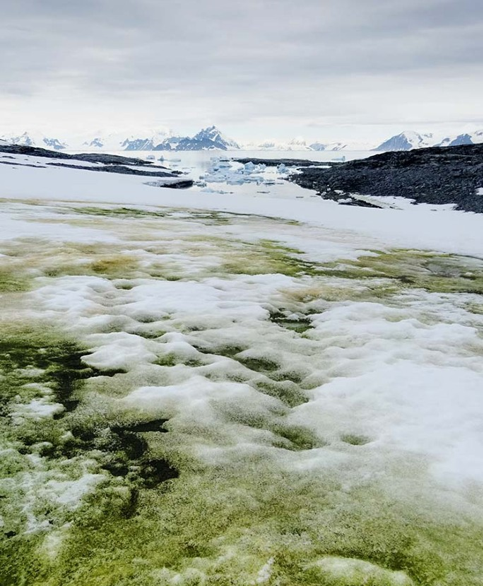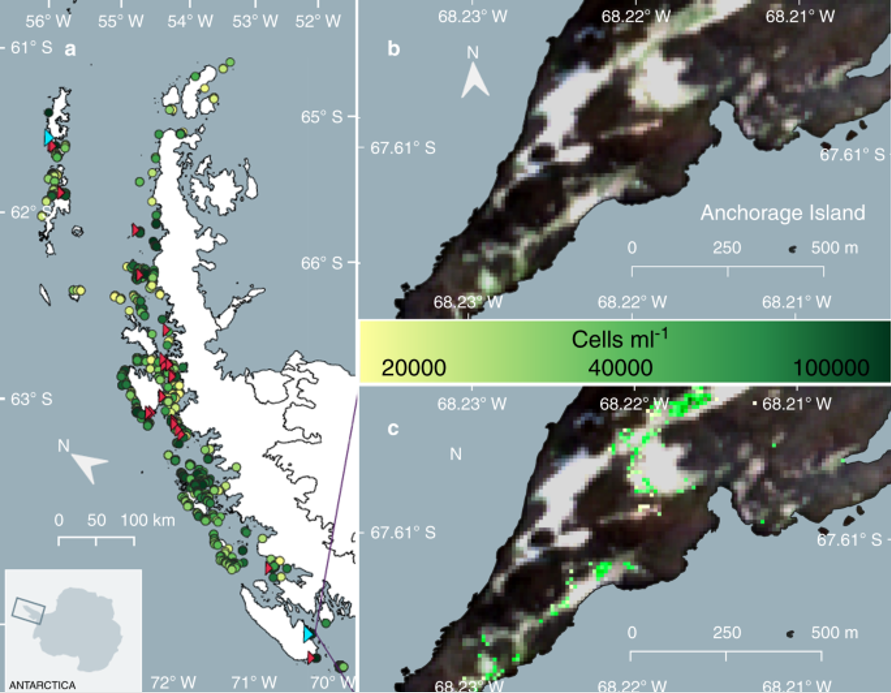Publié le 20 décembre 2022
Algae are simple, tiny aquatic organisms that are primary photosynthetic producers and form the basis of many ecosystems on Earth. Individual algae are microscopic, but they can grow to such high concentrations that their blooms are visible from space.
Research published in Nature Communications used data from the European Space Agency’s Copernicus Sentinel-2 satellites to generate the first estimate of the size and biomass of green snow algae in the Antarctic Peninsula.

Green Snowpacks on the Antarctic Peninsula
This research focused on green algae on the Antarctic Peninsula, a 1,500-kilometre stretch of land in the northernmost region of Antarctica that points towards South America.
As the climate crisis raises Earth’s temperatures. Antarctica is predicted to lose 62% of blooms occupying small, low-lying islands that cannot expand their range to higher elevations.
Net positive increase in snow algae in Antarctica
The research found that algal blooms in the Antarctic Peninsula have ecological ties to marine communities and penguin colonies. As average positive summer temperatures increase within Antarctica, the area they inhabit also increases, which may contribute to glaciers melting.
At lower latitudes, algal bloom area and elevation were found to be increasing. This positive increase is expected to outweigh any losses, resulting in a net positive increase in the biomass of snow algae in Antarctica over the coming years.
Understanding how snow algae patterns are changing and how they fit into Antarctica’s biosphere, is critical to understanding the overall impact of a warming planet on Antarctica’s vegetation.
Key to these findings were remote sensing data from the Sentinel-2 mission of the European Union’s Copernicus Programme. The mission consists of two satellites in the same orbit around the poles. Named Sentinel-2A and -2B, they both utilise multispectral imaging technology to image land and coastal areas around the world with high optical resolution.
The data generated by these satellites have applications in agriculture, forest management and ecosystem monitoring and are made freely available to anyone around the world.
Over the coming years, two new satellites, Sentinel-2C and -2D will be launched to take up the relay from the first units.
Sentinel-2 can image the entire Antarctic Peninsula every day
Lead researcher, Andrew Gray, from the School of Geosciences at the University of Edinburgh, says, “The advantage of Copernicus Sentinel-2 is that it provides continental coverage and a lot of data. Most fieldwork in Antarctica relies on research infrastructure, which limits areas of observations and results in largely anecdotal observations. We’ve now gone from that system, to being able to take a snapshot of where the distribution happens, namely why and where. That’s where the importance of high-resolution imagery comes in.”

Satellite Imagery of the Antarctic Peninsula
Snow algae are found in the summer, coastal snowpacks of Antarctica, though their distribution is global. However, it is hard for researchers to travel to these coastal snowpacks due to their inaccessibility. Despite these constraints, it is still possible to map out the region using remote sensing data.
Satellites such as Copernicus Sentinel-2 can image the entire Antarctic Peninsula every week at high resolution, allowing researchers to estimate data points such as are coverage, biomass estimates and seasonal development of green algal lifecycle stages. These factors can then also be related to snow temperature, aspect, latitude and elevation.
Ice-free ground makes up a very small percentage of the total land cover in Antarctica (0.18%). Even in the Antarctic Peninsula, the most vegetated region in Antarctica, only 1.34% of its exposed area is covered by photosynthetic organisms.
Read the rest of the article
after the jump
Source:
European Space Agency (ESA). (2022, December 19). Copernicus Sentinel-2 helps research on algal blooms in Antarctica. Sentinel Success Stories - Sentinel Online. Retrieved December 20, 2022